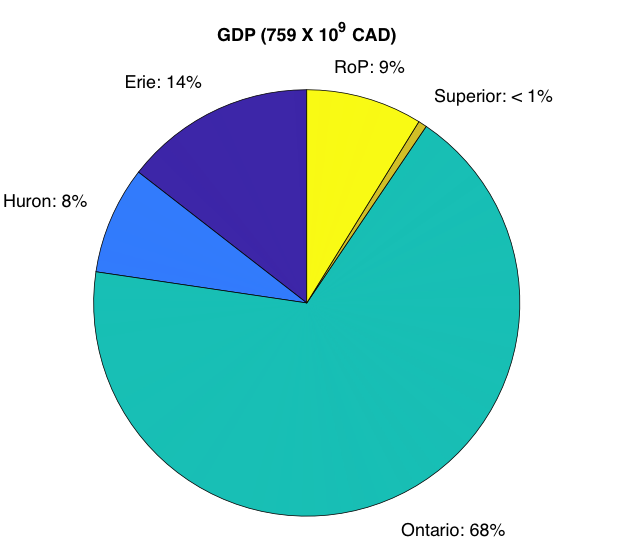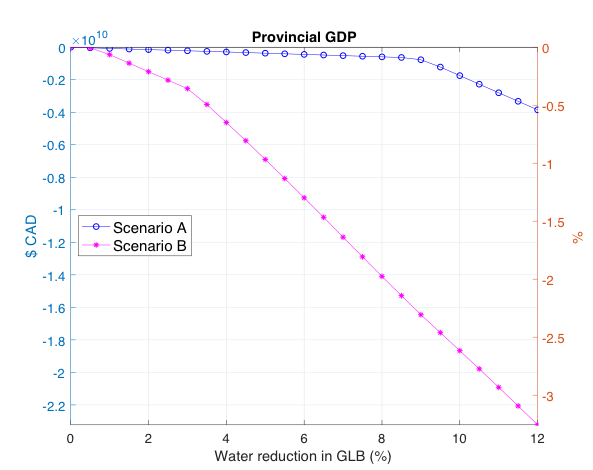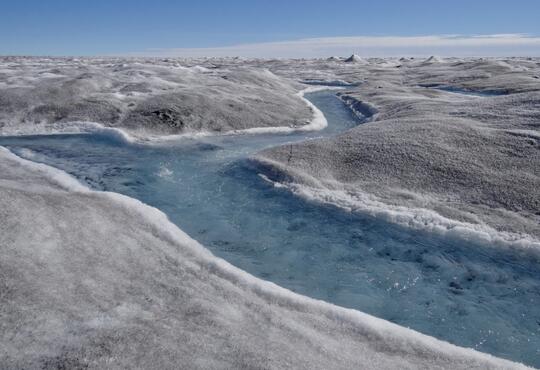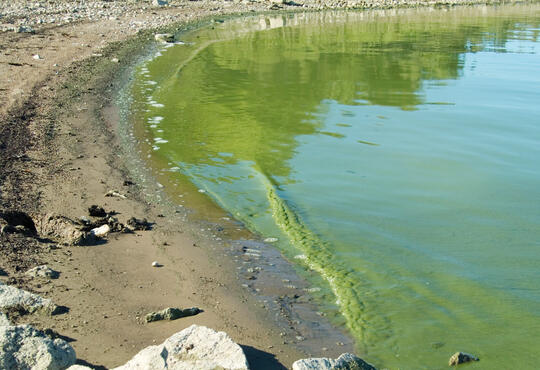 Contact
Contact
 Roy Brouwer, Department of Economics
Roy Brouwer, Department of Economics

Jorge Garcia Hernandez, Department of Economics
Introduction
There is a general perception of water abundance in Canada and Ontario in particular due to the presence of the Great Lakes (GL). However, this idea is somewhat misleading because these resources are under increasing pressure due to a growing population, urbanization, agricultural intensification, industrial use and climate change, potentially limiting their availability for future generations. A wide variety of economic activities take place around the GL that depend on these lakes for their operations as a source and a sink. More than one third of Canada’s GDP is generated in and around the GL. Hence, the economic interests potentially affected by future limitations on water availability and water use are high.
This study analyzes the direct and indirect impacts of possible future water use restrictions due to climate change on economic activities on the Canadian side of the GL by developing a novel integrated hydro-economic model for the Great Lakes. The development of such a hydro-economic model makes the often unknown and invisible value of water more explicit to local, regional, provincial and federal policy and decision-makers, local residents and the public at large.
Methodology
The study makes use of georeferenced demographic and economic census data and empirical input-output modelling approaches to build the economic structure and trade flows of each of the lakes sub-basins on the Canadian side of the GL, that is, Lake Superior, Lake Huron, Lake Erie, and Lake Ontario. Each of these sub-basins has its own specific physical and economic characteristics. Economic transactions between economic sectors, some of which are directly dependent on water like hydropower, agriculture, mining and manufacturing and others that are not (for example, most of the service and road transportation sector), are linked to water intake information by combining different available data sources from Statistics Canada.
Available economic and census data at administrative levels such as by province and municipalities are spatially disaggregated using a geographical information system to create regional lake economies and to model inter-regional trade-flows between the lake regions and the rest of the province of Ontario. This then allows us to describe the direct and indirect impacts of having water supply cutbacks on the GL economy as a whole, on targeted regions, or targeted sectors. New in this study is the inclusion of a non-linear economic optimization procedure to minimize the impacts of climate change on the GL economy and the modelling of trade flows between lake regions, between the GL basin and the rest of the province and between the GL economy and the rest of Canada.
Besides a baseline scenario describing the status quo, two future scenarios are created inspired by expected climate changes in the region. The first scenario (A) assumes that climate change would increase the current water supply pressure in the GL from one month (August) to a whole season (summer). The second scenario (B) is the same as A, but here we impose the additional restriction that food and energy security to the province as a whole and the rest of Canada is guaranteed.
Outcomes
The GL economy is estimated to be responsible for 91 per cent of GDP generated in Ontario, which is equivalent to about 35 per cent of Canada’s GDP as a whole. Lake Ontario is the region with the highest GDP contribution (68 per cent of provincial GDP), making it the overall economic engine of the province (Figure 1). This is followed by Lake Erie (14 per cent of provincial GDP), which is primarily characterized by agriculture-related industries, making this region the food supplier of the province. The GDP shares of the remaining regions are less than 10 per cent, and includes Lake Huron (8 per cent), Lake Superior (1 percent), and the rest of the province (9 per cent). The most intensive water user (power generation) accounts for 86 per cent of the total water withdrawn in the province, followed by the water sector (7 per cent), manufacturing (6 per cent) and agriculture (0.6 per cent or 130 million cubic meters per year).

Figure 1: Relative contribution of the Great Lakes and the rest of the province to Gross Domestic Product generated in Ontario in 2015
For the two scenarios, Ontario seems to be able to cope well with water reductions in the GL basin of up to 9 per cent, but only if an economically optimal water allocation plan is implemented. Such a plan would involve the reduction of water supply to certain sectors, most notably power generation. Higher future water reduction levels are expected to result in increasing marginal losses in provincial and regional GDP. This is shown in Figure 2.

Figure 2: Estimated impacts on Ontario’s Gross Domestic Product (GDP) of two water use restriction scenarios under climate change.
The total economic costs of future water supply reductions vary greatly depending on the region and sector where these reductions take place and the magnitude of the water reduction, reflecting non-linearities in economic responses to climate change. This finding highlights the need of having an integrated decision support tool to assess the potential economic costs of different water allocation plans.
Conclusions
This is, to our knowledge, the first attempt to assess the role of water in the broader economy of the Great Lakes Basin and Ontario as a whole. Until now, no comprehensive economic model was available that allowed policymakers to estimate the economic impacts of changes in water flow levels, and subsequently water supply. The hydro-economic model can assist in designing sustainable water extraction policies or contingency plans for the Great Lakes in order to deal with potential future water scarcity threats due to climate change. As highlighted in the results, such policies and plans should consider the economic spillovers to other regions and sectors and the potential impact on water, food and energy security in the region, province and country as a whole given the national significance of the Great Lakes economy.
J. A. Garcia-Hernandez & R. Brouwer (2020): A multiregional input–output optimization model to assess impacts of water supply disruptions under climate change on the Great Lakes economy. Economic Systems Research. DOI: 10.1080/09535314.2020.1805414
For more information about WaterResearch, contact Mary Anne Hardy.







